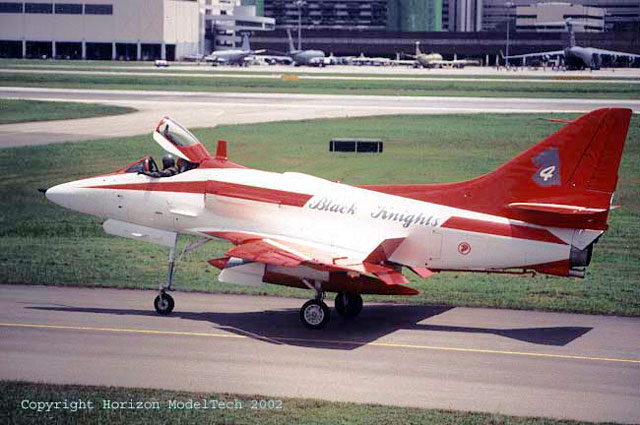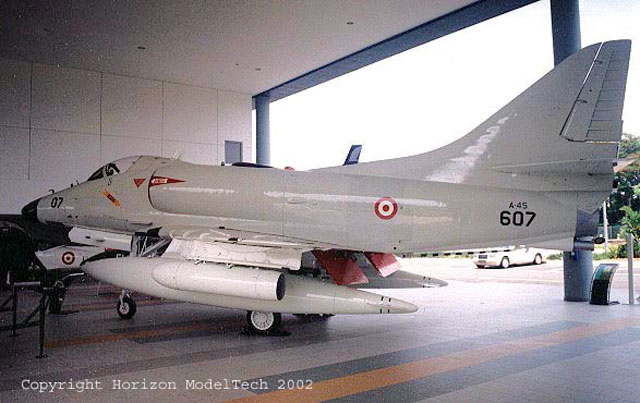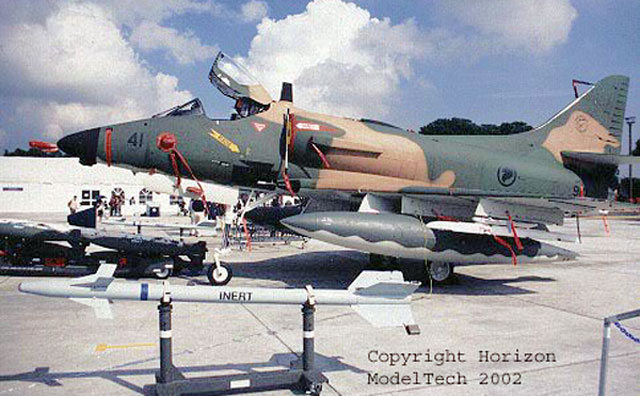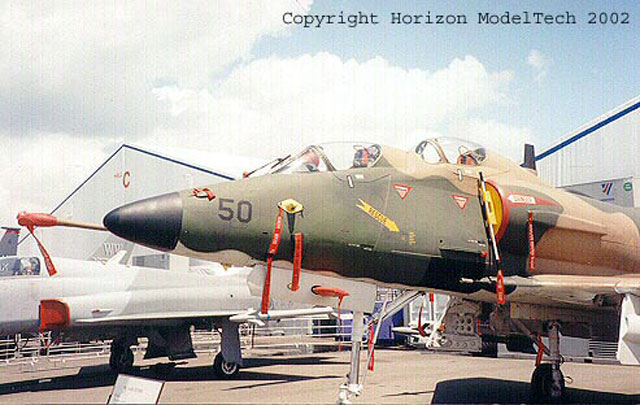|
The Singapore
Skyhawk Story
by Mike Yeo, Horizon
ModelTech
 |
|
A-4SU Super
Skyhawk
RSAF Black Knights Demonstration Team, Asian Aerospace 2000 |

HyperScale is proudly supported by
Squadron.com
|
Singapore
Skyhawk History |
The fledgling Republic of
Singapore Air Force (RSAF), formed as the Singapore Air Defence
Command (SADC) in 1968, and renamed the RSAF in 1973, started its
long involvement with the Douglas A-4 Skyhawk in 1973, when the
then-SADC ordered over 50 ex-US Navy A-4Bs and TA-4Bs from the
Military Aircraft Storage and Distribution Center (MASDC) at Davis-Monthan
AFB, Arizona. These aircraft were overhauled and modified by
Lockheed in the United States and Singapore where they emerged as
A-4S (single-seat) and TA-4S (twin seat trainer), incorporating more
than 100 changes to the standard A-4B airframes. The trainers were
not the standard TA-4 with a common cockpit for the student and
instructor, but instead were built with a second separate cockpit
for the instructor. The reasons for this would be discussed later. A
small detachment of 8 aircraft, which were rebuilt in the US,
remained at NAS Lemoore for crew training while the rest of the
airframes were shipped back to Singapore for overhaul and upgrading.
These aircraft formed 2 squadrons in the RSAF, Nos. 142 (Gryphon)
and 143 (Phoenix) at Tengah AB and Changi AB respectively. From the
initial batch of 50 airframes, 47 aircraft were built, including 3
trainers. A further 4 trainers were ordered, and these joined the
RSAF in 1977. The aircraft flew in a typical SEA scheme of
Green/Dark Green/Tan with light gray undersurfaces with the
exception of the Lemoore-based aircraft, which retained the USNís
Light Gull Gray/White schemes
After 6 years of Skyhawk operations, 70 more airframes, a mix of
A-4Bs and A-4Cs, were ordered by Singapore in 1980. These were
shipped to Singapore for rebuilding, and the A-4Cs emerged as A4S-1s
while the A-4Bs remained in storage for use as spares. In total,
around 150 airframes, all A-4Bs and Cs, were purchased by Singapore.
Along with a number of TA4S-1s, these newer Skyhawks joined the 2
Skyhawk squadrons as attrition replacements from 1982. A further
order of 16 stored TA-4Bs in 1983 resulted in conversion to 8 TA4S-1
trainers. By this time 143 Sqn had moved to Tengah AB as a result of
Changi being converted to an international airport, and in 1984 a
third squadron, No 145 (Hornet) was formed, also at Tengah.
1985 was a bleak year for the Skyhawks. In a matter of months, 4 had
been written off in separate accidents, and the situation was
further blighted by low serviceability of the remaining aircraft.
Investigation into the crashes found that the Wright J65 turbojet
engines used by the Skyhawks were too old, and the RSAF decided that
the time had come for a replacement if the Skyhawks were to be used
for any longer. A search for a suitable replacement was then carried
out, and the choice fell on a non-afterburning version of the
General Electric F404-GE-100D turbofan. An ambitious two-stage
upgrade program was launched in collaboration with the local
aerospace industry, including re-engining the entire A4S-1 fleet,
followed by an avionics upgrade to bring the avionics of the RSAFís
Skyhawk fleet up-to-date These culminated in the A-4SU Super Skyhawk,
which entered squadron service with 145 Sqn in 1989. By the early
1990s all 3 squadrons were thus re-equiped, with the last of the
venerable A-4S being retired in 1993.
Airspace in land-scarce Singapore became increasingly congested,
thus leading to an ever-shrinking area where the RSAF can conduct
itís training. Normal training is conducted over the South China
Sea, and limited use of airspace and training grounds over Malaysian
and Indonesian airspace. As such, it became imperative for the RSAF
to source for training grounds overseas, through agreements with the
host governments. In the 1990s, the RSAF decided to base a
detachment of Super Skyhawks overseas for its advanced pilot
training program. Australia was approached for the leasing of
facilities at Amberley, Queensland, but the Australian government
rejected this over noise considerations, while Singapore rejected
Australiaís counter offer of facilities in Woomera in South
Australia due to the distance from Singapore. Finally, in 1998, the
French government stepped in with an offer of facilities at Cazaux
AB in the south of France. A 25-year lease for basing rights of 18
aircraft and around 250 RSAF personnel and their families was signed
later that year. Back in Singapore, 143 Sqn disbanded in 1997 and
its aircraft were handed over to 150 Sqn, which had given up its
SIAI-Marchetti SF.260 basic trainers. The new squadron then took up
the role of advanced jet training, using its aircraft as a lead-in
fighter trainer for RSAF pilots. This made it the prime candidate
for moving to France, and the first of 18 aircraft were ďpackedĒ and
sent to France by ship in mid-1999 as part of the RSAFís Advanced
Jet Training Program.
The RSAF has had long-standing links with the air forces of other
nations, and as such the Super Skyhawks have taken part in several
exercises with the air forces of nations around the world, both
locally and overseas. These range from the Commando Sling series of
exercises with the USAF in Singapore, Exercise Cope Tiger with the
Royal Thai AF and USAF in Thailand, Exercise Pitch Black with the
USAF/RAAF in Australia, and the Five-Power series and air and naval
exercises (ADEX, Starfish and Flying Fish) with the air and naval
forces of Malaysia, the UK, Australia and New Zealand. Recently, the
RSAFís French-based Skyhawks have taken part in the ODAX series of
exercises in France. RSAF Skyhawks have also supported Singapore
army exercises in Queensland, Australia, operating out of
Rockhampton airport.
The RSAF has also used the Super Skyhawk in its Black Knights
Demonstration Team. Super Skyhawks in Black Knights colours have
appeared at a number of the biennial Asian Aerospace exhibition in
Singapore, with the 2000 team, comprising 4 A-4SUs and 2 F-16As
being the first time an aerobatics team has performed with 2
different types. 150 Sqn Super Skyhawks have also appeared at a
number of European airshows, including Waddington in the UK and
Leeuwarden at the Netherlands. Current RSAF strength stands at
around 60 Super Skyhawks, and the types distinguished service with
the RSAF is coming to an end, with the type expected to be phased
out in the coming years
|
Singapore
Skyhawk Variants |
A-4S Skyhawk
 |
|
A-4S Skyhawk
607/145013 at the RSAF Museum, Paya Lebar AB, Singapore. This
example is painted in Light Gull Grey over White, the scheme
carried by the RSAF Skyhawk detachment in the US in the 1970s. |
Initial RSAF variant.
These aircraft were built from A-4Bs bought from MASDC in the early
1970s. These aircraft were rebuilt with Lockheedís assistance
together with itís Singapore subsidiary, Lockheed Air Services
Singapore (LASS). 51 A-4S and TA-4S were built between 1974 and
1977, with 6 built in the United States and the rest assembled in
Singapore. These aircraft had over 100 modifications from the
original A-4B, including a longer nose housing a new comms/nav
package, 5 stores hardpoints instead of the usual 3, a saddle type
ADF dorsal hump, cockpit armour plating, spoilers, cranked refueling
probe, Sidewinder capability, brake parachute housing below jetpipe
and 30mm Aden cannons in place of the Mk12 20mm cannons.
Internal changes included a Ferranti D-101 lead computing gunsight
and associated weapons delivery computer. Decca provided a Type 72
Doppler system and Tactical Area Navigation System (TANS), while
Lear Siegler provided the Altitude and Heading Reference System, new
radios, IFF, ADF, TACAN and radar altimeter. The original APQ-145
mapping and ranging radar was retained. In RSAF service the
A-4S/TA-4S were given 3-digit serial starting with 6. (Eg. 600, 651)
A4S-1 Skyhawk
 |
|
TA4S-1 Skyhawk
904/148525. Notice the different antenna arrangement on the
fin base/behind the canopy on this aircraft compared to A-4S
607. A4S-1s have a similar antenna layout |
All aircraft from the
second batch of airframes onwards were built to this standard. All
A4S-1s and most of the TA4S-1s were ex A-4Cs. These were rebuilt
mainly into the same standards as the earlier A-4S, but retained the
20mm cannons and A-4C nose of the original Skyhawk. Due to
serviceability problems with the Doppler sets, these were also not
retained from this batch of Skyhawks onwards. All A4S-1/TA4S-1s were
serialled 9xx (eg. 918, 950). The first example joined the RSAF in
the early 1980s.
Late in their service lives these aircraft acquired Radar Warning
Receivers on the nose and above the jetpipes, while chaff/flare
dispensers were fitted to both sides of the arrestor hooks. Prior to
the mid-1980s, the RSAF had no in flight refueling capability, so it
was not unusual to see RSAF Skyhawks (both A-4S and A4S-1) during
this period having no probes fitted.
A-4SU Super Skyhawk
 |
|
A-4SU Super
Skyhawk 941/145071. Note the auxiliary inlet next to the main
intake. This is found only on the left side on all
F404-engined Super Skyhawks. |
The final guise of the
RSAF Skyhawk. In 1986 a two-stage upgrade program for the
A4S-1/TA4S-1 fleet was initiated by Singapore Aircraft Industries
(later Singapore Technologies Aerospace or STAe), in conjunction
with the RSAF. The first stage included a new engine to replace the
old and underpowered J65 turbojets. A non-afterburning General
Electric F404-GE-100D turbofan was selected. The new engine
necessitated some changes to the inlet to be made, along with
fitting new engine mounts, air turbine starter, hydraulic pumps,
refrigeration units and oil cooler. Two prototype aircraft, a single
and a twin-seater, were converted and designated A4S-1/F404 and
TA4S-1/F404 respectively. The first flight was made by a
single-seater serialled 919 on 19 September 1986 and was designated
A4S-1/F404 (unofficially designated A-4U). During flight tests the
new engine demonstrated vastly improved performance, including
outrunning RSAF Northrop F-5 Tiger II chase planes!
The second stage involved replacing the outdated avionics on the
aircraft. Much is still unknown about this aspect of the upgrade,
although it is known that the new avionics package includes a
Ferranti 4510 HUD, Litton LN-93 INS, mission computer, MED-2067 MFD
and processor, Bendix flight data recorder and a laser seeker in the
nose.
TA-4S/S-1/SU 2-seat trainer
 |
|
TA-4SU nose
section of 950/145033. This view shows the arrangement of the
twin stepped canopy and the general shape of the forward
fuselage. However it does not show clearly the shape
differences between the front and rear canopies |
Singapore acquired unique
twin-seaters for its Skyhawk fleet. Instead of the standard single
canopy trainer, Lockheed chose to design a totally new nose for the
TA-4S. A 28-inch fuselage plug was inserted into the front fuselage,
and a second, separate cockpit added for the instructor, with a
redesigned, outward-bulging rear canopy (not simply a second
single-seater canopy as its commonly believed) to enable better
all-round vision for the instructor. The reason for this is unclear,
we have heard 2 reasons for this: Firstly, the RSAFís fleet was made
up of J65-powered aircraft, while all trainer Skyhawks (TA-4F/J)
were being powered by J52 engines Thus, to avoid having a Skyhawk
fleet comprising of aircraft with 2 different engine types,
Singapore elected to customize itís own trainers. Another possible
reason was that Singapore wanted more trainers than the US was
willing to supply (at that time TA-4F/Js were still a mainstay in
the USN), therefore leaving Singapore with no choice but to build
itís own trainers. Whatever the reason, the RSAF has ended up with
what must be the most unique Skyhawks ever built!
For more information, including step-by-step listings of the various
differences between the different sub-types, please visit the
Reference Section of Horizon ModelTech's website at
http://horizontech.bizland.com/articles.html
|
Singapore
Skyhawk References |
-
Air International, August
1986, Key Publishing
-
Air Force Monthly, July
1991, Key Publishing
-
Wings of Fame, Vol 5,
Aerospace Publishing
-
Osprey Combat aircraft
Series No.11: A-4 Skyhawk by Lindsay Peacock, Osprey Publishing
London
-
The Cutting Edge by Goh,
Yong Kiat, Republic of Singapore Air Force
Model,
Images and Article Copyright © 2002 by
Mike Yeo
Page
Created 14 August 2002
Last updated
15 August 2002
Back to HyperScale Main
Page
Back to Reference Index |
Home |
What's New |
Features |
Gallery |
Reviews |
Reference |
Forum |
Search